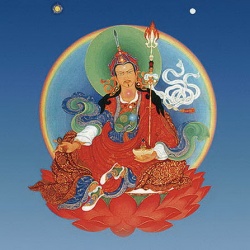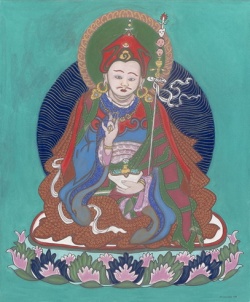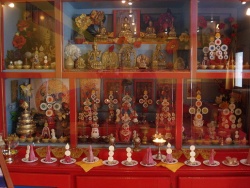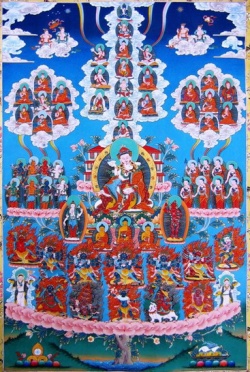The Three Inner Tantras
These three sections of tantra are the special characteristics of the Nyingma School of the Early Translations. According to Jamgon Kongtrul the First, “The Three Inner Tantras are also known as the ‘Vehicles of the Methods of Mastery’ because they establish the way to experience that the world and beings are the nature of mind manifest as kayas and wisdoms, that everything is the ‘indivisibility of the superior two truths,’ and hereby ensuring that the practitioner will become adept in the method of gaining mastery over all phenomena as being great equality.” The Three Inner Tantras are, respectively, also renowned as ‘development, completion, and great perfection’ or as ‘tantras, scriptures, and instructions.’
According to Mipham Rinpoche, the Three Inner Tantras reached Tibet through six different lines of transmission:
1) As perceived by ordinary people in Tibet, Padmakara, the Second Buddha, taught only the Instruction on the Garland of Views but bestowed both the profound and extensive empowerments and instructions of all of the Three Inner Tantras to his exceptional disciples including Sangye Yeshe, Rinchen Chok, Lui Wangpo of Khon,
and many others, the oral lineages of which have continued unbroken until this very day. Moreover, the major part of his teachings were sealed as terma treasures for the benefit of followers in future generations.
2) When the great translator Vairotsana extensively had received the profound teachings of the Great Perfection from the Twenty-five Panditas, especially from Shri Singha,
he returned to Tibet and imparted the Mind Section five times, as well as the oral lineage of the Space Section, Vimalamitra both of which are continued uninterruptedly.
3) The great pandita Vimalamitra arrived in Tibet and taught the Instruction Section chiefly to Tingdzin Sangpo of Nyang. This lineage was transmitted both orally and through terma treasures. Nubchen Sangye Yeshe
4) Sangye Yeshe of Nub received from four masters in India, Nepal and Drusha innumerable teachings headed by the important scriptures of Anu Yoga and Yamantaka.
His lineage of the Scripture of the Embodiment of the Realization of All Buddhas is still unbroken.
5) Namkhai Nyingpo received the transmission of the teachings of Vishuddha from the Indian master Hungkara which he then spread in Tibet.
6) During following generations, incarnations of the king and the close disciples of Padmasambhava have, and still continue to do so, successively appeared, as great masters who at opportune times reveal the profound teachings that had been concealed as terma treasures, in order to ensure the supreme welfare of people in Tibet and all other countries, both temporarily and ultimately.
The Inner Tantras are the final three divisions in the ninefold division of practice according to the Nyingma school of Tibetan Buddhism. They comprise the Mahayoga, Anuyoga and Atiyoga.
This system divides the whole of the Buddhist path into three divisions of three and is in contrast to the division of the Sarma, or New Translation schools (Gelug, Kagyu and Sakya) which use a fourfold division.
The three divisions of the Inner Tantra correspond roughly to the highest category of tantras of the New Translation schools, there known as Anuttarayoga Tantra.
The three divisions of the Inner Tantras are:
Mahayoga
Anuyoga
Atiyoga also known as Dzogchen or the Great Perfection.
Other schools call them "Father Tantras" (Wyl. pha rgyud), "Mother Tantras" (Wyl. ma rgyud) and "Non-Dual Tantras" (Wyl. gnyis med kyi rgyud)
Among other factors, the three divisions differ in terms of the emphasis they place on the generation stage and completion stage of tantric practice.
The Mahayoga emphasizes the generation stage, Anuyoga the completion stage and Atiyoga the synthesis and transcendence of both.
As well as being differentiated in terms of emphasis in practice, the three categories of Inner Tantra are also textual categories, with lists of texts assigned to each category; for which see the individual articles for each section.
The traditional view is that Atiyoga was transmitted mind to mind at the very beginning of time by Adibuddha, the Primordial Buddha Samantabhadra (Kun tu bzang-po) the Dharmakaya aspect of Buddha, to Vajrasattva (rdo rje sems dpa).
This miraculously caused the teachings to emerge from the unmanifest Dharmakaya into the Sambhogakaya, but in a state of total purity unsullied by imperfections and unconstrained from any limitations.
Vajrasattva communicated the prececepts through symbolic means to human and other beings who were ‘vidyadharas' (rig-‘dzin), "those who have realised knowledge of the Primordial State".
Among the non-human Vidyadharas was Garab Dorje in a previous incarnation as a deva. Garab Dorje was miraculously born to a virgin nun in Öddiyana.
He transmitted these symbolic teachings to both human and non-human dhakinis but especially to his disciple Manjushrimitra.
In turn Manjushrimitra transmitted the precepts to Shrisimha who passed them on to Jnanasutra, Vimalimitra, Padmasambhava and Vairochana, the translator.
These were the oral transmissions (gang-zag snyan brgyud). Transmission of Ati Yoga precepts is of three types: direct, symbolic and oral.
There are three inner tantras. Mahayoga is like the ground or basis.
All phenomena are recognized as the magical display of mind-as-such, of the indivisible union of emptiness and appearances.
Anuyoga is like the path. It allows us to realize that phenomena are the non-dual manifestation of space and primordial wisdom.
Atiyoga is like the fruit and allows us to realize the natural presence of primordial wisdom, beyond beginning and ending.
The general view of the inner tantras is to see all phenomena as being primordially perfect and to unite realization of the “great purity” with that of the “great evenness.”
Deities are visualized in union, symbolizing the indivisibility of emptiness and compassion, wisdom and means.
The wisdom nature of the deity is considered to be inseparable from our own buddha- nature. Action transcends accepting and rejecting.
The fruit is buddhahood in one lifetime.
Called dzogchen, ati-yoga yana, upadesha, mahasandhi or shintu-naljor thegpa, this vehicle has three series of teachings, comprising of Dzogchen sem-dé, Dzogchen long-dé and Dzogchen men-ngak-dé.
The sem-dé and long-dé series entered Tibet from India in the tenth century, but neither have been widely taught nor have they survived as living traditions in the better known Nyingma lineages.
Practice of sem-dé and long-dé declined after the eleventh century.
Men-ngak-dé was introduced later, from the twelfth century, and flourished to the present day.
Men-ngak-dé is now the main teaching and practice of Dzogchen taught in the major Nyingma lineages.
The three series of Dzogchen equate with the three statements of Garab Dorje, the Tsig Sum Né-dek - 'Hitting the essence in three points'
These three points are: direct introduction, remaining without doubt, and continuing in the state.
Sem-dé is related to direct introduction. Long-dé is related to remaining without doubt.
Men-ngak-dé is related to continuing in the state.
Sem-dé means the series of the nature of Mind (with a capital 'M'). It is the series of Dzogchen with the most detailed transmission through explanation. Sem-dé equates to direct introduction. It offers explanations as direct introduction and offers methods in terms of direct introduction.
Long-dé, relates to remaining without doubt, and has much less explanation within it than Sem-dé.
It bases itself on the fact that one has already had direct introduction and concerns itself with remaining without doubt.
It concerns methods of returning to the state of rigpa through the felt texture of subtle sensation, in which one remains without doubt.
Doubt is an experience. Being free of doubt is also an experience; it's a state in itself. Long-dé is concerned with sensation, experiential sensation.
Presence of awareness is found in the dimension of sensation.
In many different teachings of the Long-dé there are particular postures using belts and sticks (gom-tag and gom-shing or gom-ten) and supports of various kinds that have the function of pressing on certain pressure points.
These pressure points are used to cultivate sensation, in which one finds the presence of awareness.
sKu-mNyé is another similar method. It utilizes sensation by stimulating the tsa-lung system.
Men-ngak-dé relates to continuing in the state.
It contains very little explanation indeed.
There are simply directions for how to continue in the state.
There are a great variety of methods within the Men-ngak-dé, but their character is very difficult to discuss outside the level of experience required to understand their significance.
There is some disagreement in the Nyingma School, whether Dzogchen is a tantric vehicle or whether it exists within its own category.
Atiyoga as it is taught in better known lineages lacks aspects of sem-dé and long-dé.
It is the direct approach to the essential nature of the mind, which is Buddha nature (De bZhin gshegs pa'i sNying Po) through the recognition of the naked awareness state of one’s own mind.
These teachings were transmitted by Vajrasattva (rDorje Sems ba) to the nirmanakaya Prahevajra who in turn transmitted them to humans teachers including Padmasambhava, Vimalamitra and Vairocana.
They have three divisions:
Those of Mind, Great Expanse and Instructions.
The Nying ma gyud bum has 21 texts of Mind and seven of Great Expanse divisions.
The Division of instructions of the Innermost Essence are contained in the 17 tantras also in The Nying ma gyud bum.
View
The view is established that all phenomena are spontaneously enlightened from the beginning.
Meditation
Through the teaching of the natural revelation of cutting through all substantial and insubstantial phenomena (khregs.chod) to realise dharmakaya wisdom. Use the spontaneous wisdom of the sambhogakaya and achieve the rainbow body of the nirmanakaya, which are spontaneous luminosity (Thod.rgyal).
Activity
Without acceptance or rejection you recognise phenomena as the display of the dharmakaya.
Fruit
Samsara is nirvana: The realisation that the spontaneous perfect state of Kuntuzangpo is ever present and that there is nothing beyond this is enlightenment.
Being a Nyingmapa, is to be open to the whole stream of practice.
Although the emphasis is on the three inner tantras one is open to any or all the yanas, and you practise that under a teacher.
Your teacher might teach from the perspective of Dzogchen but even so, he or she may give teachings from any of the vehicles.
He or she will give guidance according to the particular needs and experience of the practitioner at that time.





